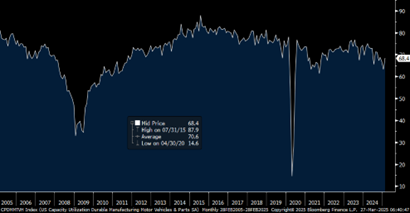It seems like we're about to learn where that fine line is between encouraging more auto production (both finished product and parts) to come back to the US — and still making cars/trucks that Americans can afford to buy. You need the latter in order to make the former viable, advises Peter Boockvar, editor of The Boock Report.
I'd guess the used car market is the better one to be in right now. We'll see how CarMax Inc. (KMX) trades.
We'll also soon find out how many US production/manufacturing jobs that will be created will be offset by job losses in the US service sector. As an example of why, many Canadians are canceling their vacations to the US – and I'm sure other foreigners will follow. According to the BLS, there are almost 17mm people employed in the US leisure and hospitality sector.
Also, many companies in the auto industry made long-term planning decisions upon completion of the USMCA that replaced NAFTA. How do they respond now with the possibility of a new president in four years reversing decisions being made now? It might not be reversed...but it might. We'll soon see.
How much capacity is currently being utilized in US manufacturing facilities (where what's left will have to handle immediate reshoring)? As of February, it was at 68.4%. That compares with the 20-year average of 70.6%. So, not much of a difference...which means that a lot of new facilities and assembly lines will have to be built. But I'd imagine each new building would take a few years to get built and fully tooled up. What happens then if soon after completion the tariffs are reversed or lowered?

As seen in the chart here, capacity utilization did get as high as 87.9% so I guess there is room to reshore. But in 2015, that was also a time when interest rates were zero and financing costs were extremely cheap. Now we're going to have even-higher car prices and elevated borrowing costs.
















